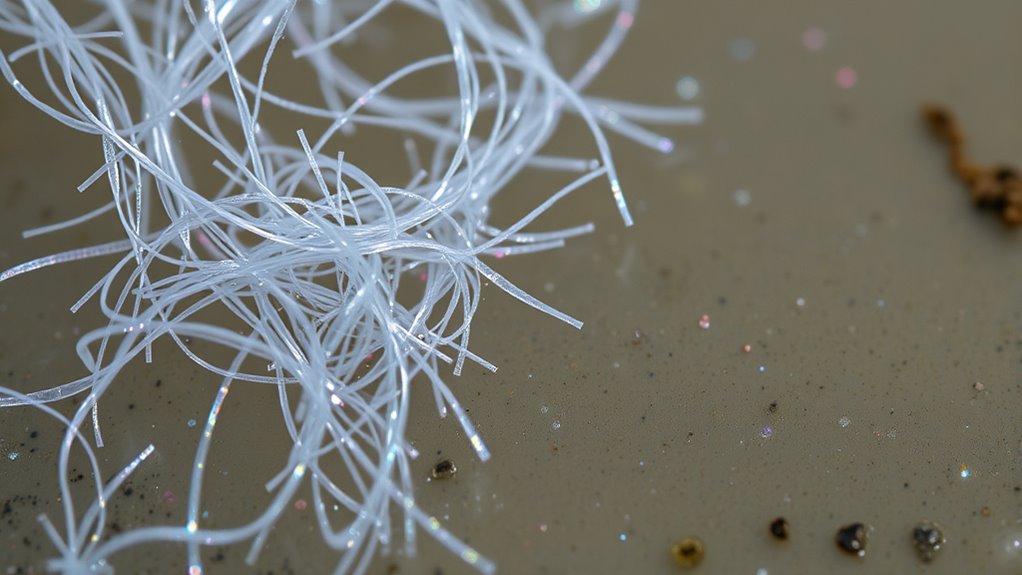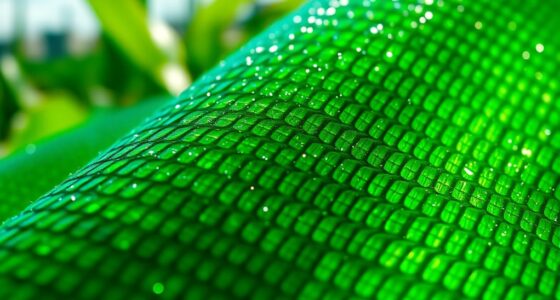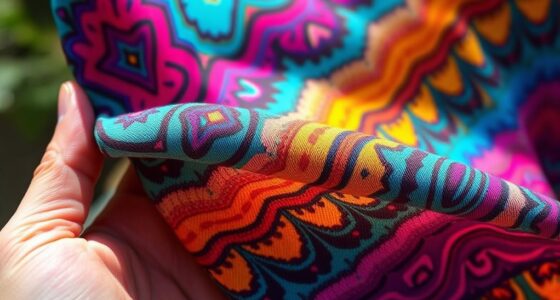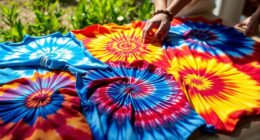Every time you wash synthetic clothes, tiny microfibers are released into your wastewater, which can escape filtration and pollute oceans and waterways. These microplastics harm marine life and persist in the environment, contributing to a global pollution problem you might not be aware of. Choosing natural fabrics, installing filters, and altering laundry habits can make a difference. If you stay curious, you’ll discover simple ways to reduce this hidden pollution and protect ecosystems.
Key Takeaways
- Synthetic fabrics like polyester and nylon shed microfibers during washing, contributing to hidden microplastic pollution in water systems.
- These tiny fibers bypass wastewater treatment, accumulating in oceans and harming marine ecosystems.
- Installing washing machine filters and choosing natural fabrics can significantly reduce microfiber release.
- Washing clothes less frequently and using gentle cycles help minimize fiber shedding.
- Consumer awareness and eco-friendly laundry practices are crucial in addressing the overlooked microplastic pollution from clothing.

Have you ever wondered how your everyday clothing might be contributing to microplastic pollution? Every time you wash your clothes, tiny fibers break off from fabrics like polyester, nylon, and acrylic. These textile fibers shed during washing, and many of them are so small that they escape traditional wastewater treatment processes. Instead of vanishing completely, these microfibers find their way into rivers, lakes, and oceans, adding to the growing problem of microplastic pollution. This shedding occurs with virtually every wash, especially from synthetic fabrics, which are designed to be durable but tend to release more fibers over time. The more often you wash your clothes, the more fibers are released, gradually accumulating in the environment. Recognizing this, many experts recommend implementing washing machine filtration systems to catch these fibers before they reach wastewater streams. These filters act as a barrier, trapping microfibers during the rinse cycle and preventing them from being discharged into the environment. Installing a washing machine filter is a simple yet effective step you can take to reduce your contribution to microplastic pollution. It’s a small change that can make a significant impact, especially when combined with other habits like using cold water washes or choosing natural fabrics. But understanding the importance of textile fiber shedding and filtration isn’t just about individual action; it’s about raising awareness of how everyday decisions affect the environment. When you buy new clothes, consider selecting natural fibers like cotton, wool, or hemp, which shed fewer fibers compared to synthetic options. Additionally, being mindful of how often you wash your clothes and opting for eco-friendly laundry practices can further reduce fiber shedding. Many clothes can be washed less frequently, and using gentle cycles can minimize fiber loss. Some advanced laundry detergents also contain ingredients that help reduce fiber shedding. Furthermore, understanding the second trimester can help you better manage your laundry routines during pregnancy, ensuring both your health and the environment are protected. Ultimately, the goal is to recognize that microplastic pollution isn’t just a distant problem—it’s happening in your own laundry routine. By installing washing machine filters and making informed choices about your clothing, you’re actively participating in a broader effort to curb microplastic pollution. Small changes in your laundry habits can prevent countless microfibers from entering our water systems, helping protect marine life and ecosystems. So, the next time you toss your clothes into the wash, remember that your actions can influence the health of the planet. Taking steps like installing filters and choosing sustainable fabrics empowers you to make a difference, turning your everyday routine into a proactive effort against the hidden threat of microplastics from clothing.
Frequently Asked Questions
How Can Consumers Identify Clothing That Sheds Fewer Microplastics?
You can identify clothing that sheds fewer microplastics by checking fiber durability and dye stability. Look for garments made from natural fibers like cotton, wool, or hemp, which tend to shed less than synthetic ones. Also, choose clothing with high dye stability, as poorly dyed fabrics release more microplastics during washing. Reading labels and opting for eco-friendly brands can help you make better choices for reducing hidden pollution.
Are There Specific Washing Machine Types That Reduce Microplastic Release?
Think of it like the Guardians of the Galaxy protecting the universe—your washing machine can do the same. Look for models with washing machine modifications that include integrated microfiber filtration systems, which trap microplastics before they reach wastewater. These systems actively reduce plastic shedding, making your laundry routine more eco-friendly. By choosing such appliances, you’re taking a stand against hidden pollution, just like heroes defending the environment’s future.
What Are the Long-Term Environmental Impacts of Clothing-Derived Microplastics?
You should be aware that clothing-derived microplastics can cause long-term ecosystem effects, such as disrupting aquatic food chains and harming wildlife. These tiny particles often bioaccumulate in animals, posing risks to predators higher up the food chain, including humans. Over time, this accumulation can weaken ecosystems’ health and resilience, making it vital to reduce microplastic release and support sustainable fashion choices to protect our environment.
Can Natural Fibers Also Release Microplastics Into Waterways?
Yes, natural fibers can release microplastics into waterways. Imagine fibers shedding during washing, with dye leaching into the water, creating tiny particles that escape filtration systems. While natural fibers might seem environmentally friendly, they still contribute microplastic pollution through natural fiber shedding, which can pose risks to aquatic life. You should consider how even eco-friendly clothing can impact waterways, emphasizing the importance of better washing practices and fiber management.
What Policies Are Being Implemented to Regulate Microplastic Pollution From Clothing?
Governments are implementing regulations like banning microbead plastics and setting industry standards for textile manufacturing to reduce microplastic pollution from clothing. You can support policies that promote eco-friendly fibers and demand better filtration systems in washing machines. Staying informed about these regulations helps you make sustainable choices, encouraging industries to adopt cleaner practices. These policies aim to minimize environmental impact and protect waterways from microplastic contamination.
Conclusion
As you wash your clothes, tiny microplastics escape, floating like invisible dust in the water—unseen yet everywhere. It’s a quiet reminder that every wash cycle releases more pollution into our lakes and oceans, just like the fibers slipping from your sweater. You might not see them, but these tiny fragments are part of a bigger picture—one where your everyday choices ripple through the environment, shaping a future that’s both fragile and interconnected.










